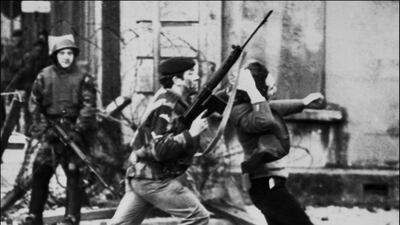The British government ordered troops into Northern Ireland 50 years ago in a planned small-scale operation to quell rioting that grew into a bloody military operation that dominated UK politics for decades.
The government of Prime Minister Harold Wilson sent several hundred soldiers to Northern Ireland's only Catholic-majority city of Londonderry in 1969 where complaints from residents about discrimination devolved into violence.
The deployment of troops is often seen as the start of what has become known as The Troubles, in which more than 3,600 people died, during more than 30 years of sectarian strife.
A growing civil rights movement to protest against the marginalisation of Northern Ireland’s minority Catholic community developed into a broader armed struggle for a united Ireland independent from Great Britain.
The troops arrived in the city on August 14 after days of clashes in the city’s Bogside district between residents and the police, who were accused of using brutal tactics against the predominantly Catholic protesters.
The disturbances began after the residents sought to prevent a march by members of the Protestant community marking victory in a 17th century city siege — sharpening sectarian tensions in the city.
The troops were originally welcomed by Catholic residents of the city who saw their arrival as a sign that police had lost control of the area during the disturbances called the Battle of the Bogside. Residents had erected barricades to keep the police out of an area named Free Derry.
“The army was called in here because the police couldn’t do its job,” said former MP Bernadette Devlin in footage from August 1969. “If the army is here as an impartial force to uphold law and order, we will talk to the army because it’s the police we’ve been fighting.”
Nobody died during the clashes in Londonderry but the disturbances spread to the capital Belfast where Patrick Rooney, nine, was killed inside his home by a suspected stray police bullet, making him the first child to die in The Troubles.

Despite the initial welcome for the troops, the army came to be seen as an occupying force with more than 25,000 troops in the province.
After being the birthplace of The Troubles, Londonderry became the scene of one of its most deadly episodes when 13 peaceful marchers were shot dead by troops in January 1972 that became known as Bloody Sunday. Prosecutors announced this year, that a single former soldier would stand trial for murder.
The original Battle of the Bogside is being marked with a series of events at the Museum of Free Derry, which is staffed by relatives of those who were killed on Bloody Sunday.
It is seen as a seminal moment when a marginalised community found its voice and became united, said Julieann Campbell, the museum’s heritage and programmes coordinator, whose uncle was the first person to be killed on Bloody Sunday.
“There was absolute anarchy but nobody died,” she said. “It was seen as an uprising of the people and an expression of the resistance of the Free Derry community. It’s important for the community that this uprising helped change things here.”
Events in Londonderry spurred recruitment to the Irish Republican Army which launched a gun and bombing campaign against British troops in 1970.
The violence spread to mainland Britain with high-profile attacks on targets including the 1984 Brighton hotel bombing targeting the UK political leadership. Five died but then prime minister Margaret Thatcher escaped injury.
The military operation continued for 38 years until July 31 2007, when troops pulled out in a low-key departure, nine years after a power-sharing deal to end the violence.
Tensions remain with high unemployment and complaints from people in Londonderry that most investment goes to Belfast. During the anniversary of the clashes this week, petrol bombs aimed at police, were thrown from the Bogside for three consecutive nights.


